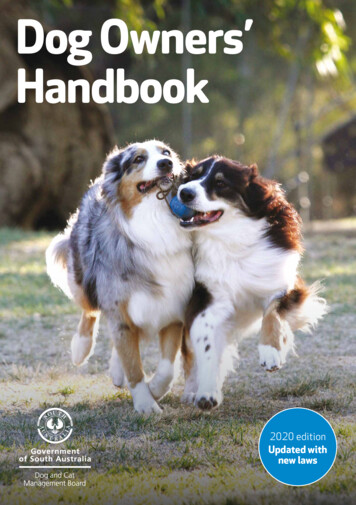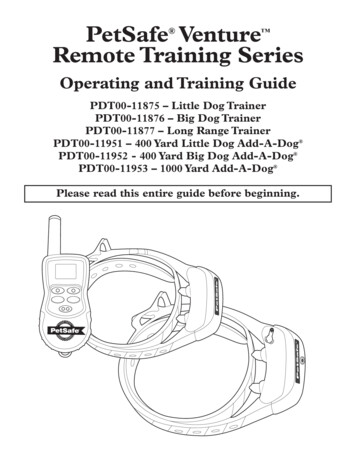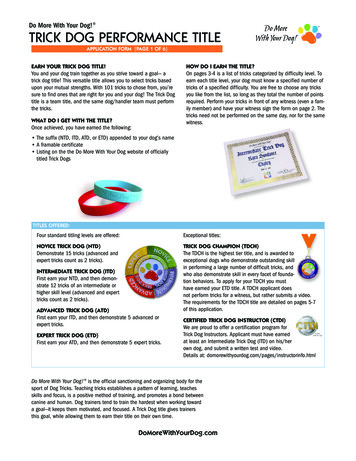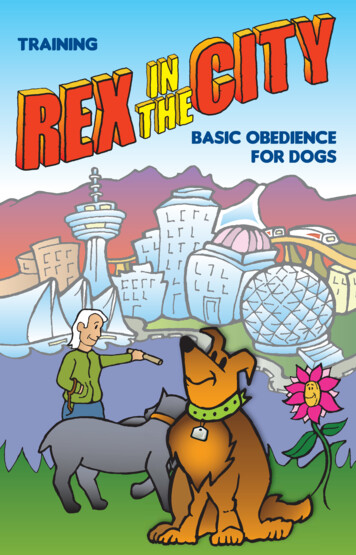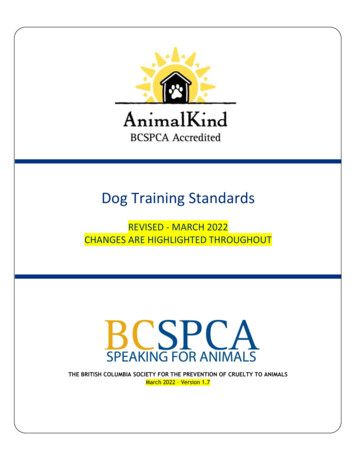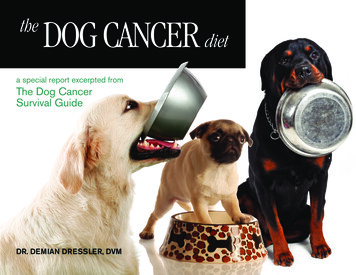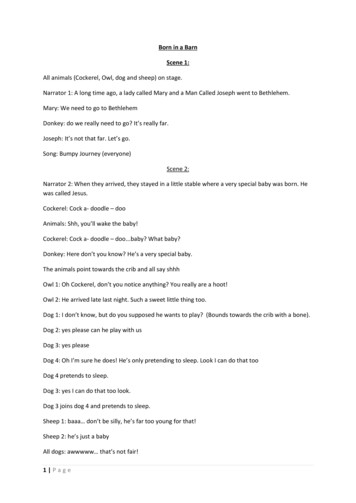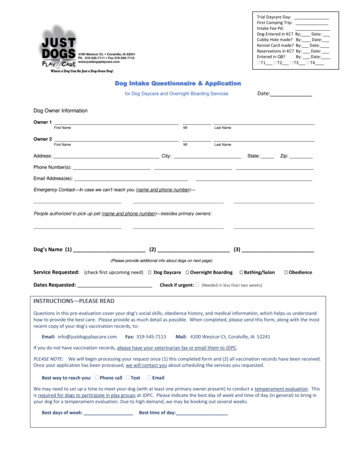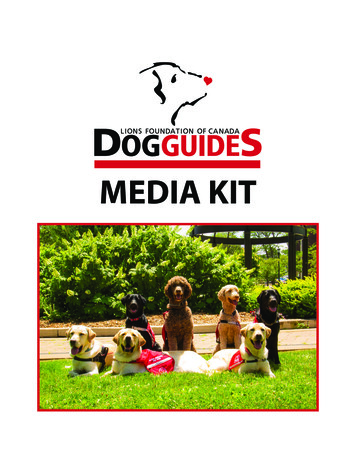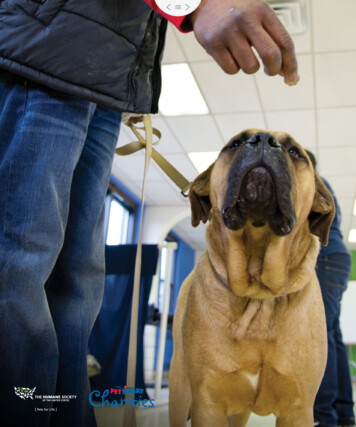
Transcription
XIIDog Training Classes“ What we have to learn to do, we learn by doing.”—Aristotle
XIIDog Training ClassesYou’ll achieve the most overall success with the classes by opening themto all breeds, ages, and levels of training, and by always focusing on andteaching positive reinforcement. To raise people’s understanding of basic dogbehavior and overall pet care.Kenny Lamberti To expose people to fun and positive activities withtheir dog, such as dog sports and therapy work. To create a forum to share information about broaderanimal welfare issues, such as spay/neuter, shelterYou might want to consider providing free dogoverpopulation, general pet wellness, and ways totraining classes to your community of focus.get involved in animal welfare.Dog training is considered a luxury item that mostpeople want and need, but cannot afford. Providing To extend dog training services to pet owners inthis service offers a unique opportunity to elevate theunder-served communities where the luxury ofhuman-animal bond. Classes help build trust with dogtraining has been limited or nonexistent.owners by making their interactions with their dogsfun. The interactions you can have with communitymembers at a fun and effective training class provide To mentor students identified as leaders who maybe interested in becoming trainers.an excellent way to connect and develop more indepth relationships with clients.Objectives of free dog trainingclasses are: To create opportunities for students to becomeanimal advocates in their own communityand beyond. To provide a new, fresh training approach for animal To elevate the human-animal bond.professionals as an alternative to the traditionalindustry standards. To keep dogs in their homes and decrease shelterintake and euthanasia. To provide pet owners with positive and funactivities to share with their dogs. To provide dogs a mentally and physicallystimulating lifestyle.148
PFL Training PhilosophyAlthough the relationship-based approach of PFL dogPFL uses a relationship-based approach to enhanceit does fit into the Positive Reinforcement quadrant.and elevate the bond between dogs and theirPositive reinforcement-based dog training buildshuman companions. The PFL approach focuses onconfidence in dogs and trust in the human handler,understanding why dogs exhibit specific behaviorswhich elevates the bond between dog and owner.and how strengthening the relationship and improvingThis is one of the fundamental principles of PFL dogcommunication between human and dog can createtraining. The PFL approach teaches dogs what theya healthy, happy, and lifelong partnership. PFL dogshould do instead of focusing on what they shouldtraining is inclusive, not exclusive, and employsnot do. On the other hand, positive punishmenttechniques that do not use fear, pain, or intimidationapproaches teach dogs what not to do withoutas motivation.providing an alternative behavior. PFL dog trainingtraining is different from the four quadrants above,does not practice this type of training because of theobvious physical pain, discomfort, and emotionalPositive ReinforcementNegative ReinforcementADDING a GOOD stimulus to INCREASE theREMOVING a BAD stimulus to INCREASE thelikelihood of a behavior: The stimulus can belikelihood of a behavior: The stimulus can be a toe/a treat, praise, petting, toy, etc.ear pinch, physical handling, or an electric collar. Reward Shaping Marker Modeling Motivation Capturing An electric collar to reinforce a come when called Proofing Back chaining Luring Counter conditioning Jack pot Toe or ear pinch when teaching a retrieve Physically pushing/pulling a dog into position Releasing tension after choking on a choke collarPositive PunishmentNegative PunishmentADDING a BAD stimulus to DECREASE theREMOVING a GOOD stimulus to DECREASElikelihood of a behavior: The stimulus can be athe likelihood of a behavior: The stimulus canchoke, pinch, or electric collar; shouting; hitting;be ignoring jumping until it stops.hand/foot corrections; or other dogs (in the caseof anti-social/under socialized behavior). Extinction Extinction burst Compulsion Aversive consequence Dominance Alpha role Flooding (exposureresponse prevention) Correction Learned helplessnessCommunity Outreach Toolkit Removing a toy, treat, praise, and attentionDog Training Classes149
trauma for the dog, and because undesired behaviorsapproach shares information with dog owners aboutoften return when the punishment stops. Thesecommon behavior concerns, such as house breaking,approaches damage the trust between the dog and thechewing, transitioning dogs indoors, leash walking,owner, breaking their bond. With PFL’s goal of keepingdog-to-dog interactions, and many more. Throughdogs in their homes for life and providing sustainabledog training, PFL identifies new ambassadors andtraining tools, PFL dog training considers the long-advocates, creates a platform for issues, such asterm connection between human and dog.spay/neuter, and creates a new audience thathistorically has not viewed rescue or adoptionPFL’s relationship-based training teaches the dogas an option. Furthermore, it fosters positiveto focus on his handler and not on his environment.relationships with the community.The PFL method teaches dogs non-reaction in theface of distractions through the Focus on HandlerWith a unique approach to dog training, PFL uses aapproach and does not push socialization with others.testing system called Certified Pet Partner. It is designedNot every dog enjoys or desires social interactionto showcase the relationship and understandingwith other dogs and people, and not every dogbetween the handler and dog. This test is used as ahas the appropriate social skills to engage in thesemeasurement for the program but also provides ainteractions. Forced socialization creates stress andway to solidify the human-animal bond and a sense ofbreaks down trust between the handler and dog,accomplishment for the owner. The test and additionalwhile the Focus on Handler approach enhancesinformation is provided at the end of this chapter.communication, understanding, and confidence andavoids stress for the dog. For dogs who enjoy socialOutreachinteraction with people and other dogs, PFL trainingteaches and facilitates appropriate greetings and socialIdeally, training classes should be located within yourconduct to give both dogs and handlers the best skillsneighborhood of focus. Depending on the region andfor real-life experiences.season, you can hold them in a facility, parking lot, orpark. You’ll achieve the most success by opening themPFL works to keep dogs in their homes and with theirto all breeds, ages, and levels of training.families for life, and works to provide tools to ensurethe highest quality of life. The PFL dog trainingAfter establishing a location, market your classesusing the same PFL methodology used for communityoutreach. Training classes should be open to allinterested dog owners and promotions should bestrategically targeted in your area of focus. Create a simple flyer with pertinent information(when, where, what). Only post flyers in your areaof focus.Sample Dog Training Flyer Go door-to-door to promote just as you do withgeneral community outreach, as discussed in Free dog training class in Durham, NC150Chapters 7 and 8.
Do not use traditional marketing such as Facebook,The more engaged the students are, the moreTV, radio, etc., as this will ultimately draw clientsconsistent their attendance will be and the strongerfrom outside your focus area.relationship they will build with their dogs. A sk people to share details with others they knowwho have dogs—word of mouth works. ho Makes a Good PFL-StyleWDog Trainer?Classes should be open enrollment, meaning thatEvery dog trainer has his or her own personality andclients do not have to pre-register to attend. Makestyle; this is what makes classes fun, engaging, andsure this is clear on marketing materials. Becauseholds the attention of the class. The right trainer forchanging circumstances often make it difficult forPFL-style dog training has a full understanding ofclients to plan ahead for a training class, you do notall dog training philosophies, is dynamic, and has awant to discourage attendance; the goal is to bring outstrong presence. Most of all, the trainer has qualitypeople who haven’t had access to training in the past.people skills and likes people as much as they likeDepending on the demand, more than one class perdogs. The trainer should genuinely care for the clients,week should be scheduled. If that’s not possible, assesswhich creates deeper relationships between traineroverflow students and put them on a waiting list for theand clients, and in turn, the dogs.next class or help them with any pressing issues (andpossibly schedule them for home training sessions).To be successful at PFL-style dog training, the trainermust be open and accepting—it is important to meetClients should be welcome to attend as many or as fewthe clients where they are. This means setting asidesessions as possible, and should never be made to feelall judgment of clients’ “training techniques” and theirbad for missing a class. Your level of follow-up with theinteractions with their dog. Until the trainer develops astudents each week between classes will have a majorrelationship with the clients, no credibility exists. Theimpact on consistent attendance. To ensure consistenttrainer must demonstrate by example a better way forattendance and truly address any issues studentsclients to interact and communicate with their dogs.are facing with their dogs, all clients should get atThis is why it is vital to understand all methods of dogleast one phone call or home visit each week betweentraining, whether positive or negative, in order to showclasses. This call serves as good customer service toand share knowledge when questioned or challenged.thank people for attending, as well as, a reminder forthe next class. Keeping students engaged is the way toA trainer should also have the ability to improvise andensure that they get the most out of the classes and toreact to an ever-changing group class environment.build the strongest bond possible with their dogs.Because the class is open admission, varying numbersof students and dogs will arrive at class each week.Clients who struggle in class should get a call to makeSome dogs will be under-socialized and reactive, sothem feel comfortable, let them know that what theythe trainer must remain calm and in control of theare experiencing is normal and okay, and encourageclass, regardless of the situation. To maintain a safethem to return. You want to ensure that every studentand enjoyable environment, the trainer will also needhas a positive experience and doesn’t think their dog iscompetent volunteers to assist in managing check-in,failing in any way. If possible, struggling students shouldthe clients, and the dogs. The trainer should train thereceive a home visit to provide additional guidance.volunteers in the skills required to provide effective,safe, and fun classes.Community Outreach ToolkitDog Training Classes151
Volunteers Hold leashes while students register for classVolunteers are essential to the success of the training Escort students to assigned “place” as determinedclasses. Volunteers should receive training from theby the head trainerhead trainer and understand the PFL philosophy.Holding a volunteer orientation, specifically for Hold leashes during class as neededtraining class volunteers is most effective. At thisorientation, the head trainer can communicate the Assist in fitting collars and harnesses as neededappropriate code of conduct in class, the language touse and not use, skills to know (e.g. effective defensive Break down of “place” spotsleash handling, class set-up, and maintaining classflow), and all other details necessary to hold safe and Break down of registration tablefun training classes.Volunteers are not to instruct students or give trainingDefensive Leash Handling Hold the leash approximately two feet fromadvice unless specifically requested by the trainer.However, volunteers will often assist students withexercises and instructions given by the trainer.the collar. At this length, if the dog turns onthe handler, the leash is shorter than theClass Detailshandlers arm length and the handler canreact in one motion to keep safe.Class size is determined by the comfort level ofthe trainer and the training space’s size. Because Maintain light tension on the leash at allthe classes are open enrollment, be sure to havetimes so that the handler is aware of wherea plan in case more students show up than can bethe dog is without having to look.accommodated. Designate a specified person to greetany overflow students and collect their information. The handler should loop the leash over theIf a second trainer or trainer’s assistant is available,thumb and through the palm of the hand forhe or she could take extras on a dog walk, do minimaladditional support and strength.training in a separate area, or simply chat with them toreschedule and share basic information. The key isto make everyone feel welcome and to ensure themTraining class tasks for volunteers are:you’ll be in touch for additional training opportunities. Set up registration tableMost trainers and locations will be comfortablewith a class size between 10–25 students. The level Prepare and refill treat bagsof experience with group classes and the qualityof volunteers and training assistants available will Prepare and refill water bowls and setin place around the training areadetermine where in this range your classes shouldfall. Usually an outdoor space will accommodatemore students and have greater options for spacing. Set up “place” spotsHowever, an indoor space is not affected by weatherand is often a more controlled environment. Greet and welcome students152
Regardless of the venue, there should be a clear andorganized set-up for the class as follows:[5] A ll students are advised to keep their dogs close tothem and not to allow their dog to interact with anyother dog. Registration table clearly marked—all studentsshould enter at this location before reaching the[6] The trainer is at the registration table to greettraining area. This allows for the easy interceptionclients, quickly assess the dogs, and assign themand assessment of dogs before they reach the spacea “place” spot. Assignments are made based onto greet each othersize and reactive tendencies. Size related trainingtechniques are relevant because teaching a 12 lb.dog to lay down can be different from teaching a Data collection table60 lb. dog to lay down. If small dogs are grouped Tents/canopies set up over registrationand data collection table (if outside)together, the trainer can instruct them together,which is most effective and efficient. Dogs thatappear to be reactive will be grouped away fromthe other dogs. However, small reactive dogs Chairs for spectatorsshould be grouped with other small dogs ratherthan large reactive dogs. Water bowls for dogs Cones to delineate the training area[7] T raining assistants escort students to theirassigned “place.” “Place” spots in the training area—these should bespaced a minimum of six feet apart. If space permits,[8] Students are advised to keep their dog on/in theassigned “place.”a 12 ft. minimum is preferred.As the clients arrive, the process should be:[9] Volunteers are stationed close by for assistanceif required by a student.[1] Students are welcomed and greeted by volunteers.[10] V olunteers remind students of no dog interaction[2] Students register and fill out necessary paperwork.[3] A ll dogs are checked for a well-fitting collar—welland other safety precautions.Supplies needed for classes:fitted is determined by whether the dog can getfree from the collar. Any too-loose or too-tight “Place” spots—cones, boxes, tape on the floor, etc.collars or harnesses are replaced, as are chains,ropes, wires, etc. At this point, loop leashes, choke,and pinch collars are all accepted. You will have Treat bags (Home Depot fabric tool aprons are cheapand practical)time to individually and thoroughly engage peopleabout the types of equipment to use, but not Voice projection device, if neededduring registration. Tables and chairs[4] Each student is handed a treat pouch filledwith treats. Tents/canopies, if outdoorsCommunity Outreach ToolkitDog Training Classes153
Registration paperwork—data collection forms,Sample Class Rules:sign-in sheet, liability waivers One handler per dog permitted in the training area Training handouts No children under 14 permitted to handle a dog Traffic cones Dogs are not allowed to play with or greet other dogs Martingale collarsunless directed by the trainer Buckle collars Dogs must stay on leash unless directed by trainer 6-foot leashes Focus on your training; don’t excite or play withother people’s dogs Head halters A lways ask the handler’s permission before offering Easy walk harnesses Temporary leadstreats to a dog that is not your own Try to keep conversation quiet and to a minimum; itcan be distracting to people and their dogs Dog waste bags No human food allowed in the training space Water bowls Keep cell phones off and put awayFor the class itself, Basic and Advanced curriculum areprovided at the end of this chapter. If you need to leave the space for any reason, makesure to let the trainer know so you don’t disrupt classAs discussed earlier, every trainer has his or her ownstyle and preference for how to run group classes, but Absolutely no hitting or yelling at any dog in classthe flow for each class generally follows this schedule: Most importantly, HAVE FUN![1] Greeting/welcome[2] Explanation of what will happen during the classIn-Home Training Sessions[3] Class rulesAs a supplement to or instead of group trainingclasses, in-home dog training sessions can be very[4] Curriculum for classbeneficial to your clients. They can help elevate thebond clients have with their dogs to keep dogs in their[5] Games and prizes[6] End of session154homes for life.
In-home training sessions are ideal for:In-home training sessions not only benefit the clientand the dog but provide you with the opportunity to Clients struggling in group classes (with the goalof returning to class)build a trusting, positive relationship with the client.You might also engage clients on spay/neuter andother general wellness topics. When a client sees Clients unable to travel or make it to group classesimprovement in their dog’s behaviors or sees issuesdisappear that have been stressful or overwhelming, Clients with highly reactive dogs (with the goalof eventually attending group classes if possible)not only are you increasing the odds that the dog willremain in that home, but you are setting yourself upto be a trusted resource for any questions or issues Elderly clients who are safer working with theirthat client may have.dog at homeCommunity Dog Walks Clients with two or more dogs (and who are unableto handle multiple dogs at once in class)In addition to or instead of group classes and in-hometraining sessions, your training program can includeThe key to success for in-home training sessions iscommunity dog walks. If you are unable to securestructure and consistency. First, create a schedule thata building or space to hold group training classes,works for both the client and trainer. If sessions everycommunity dog walks can teach skills and improveother week are all that is possible, that’s okay, butthe bond between clients and their dogs. Communitybe consistent. It’s better to have more time betweendog walks are designed to encompass all of the basicsessions than to miss scheduled sessions. Next, haveskills that a client and their dog need to enjoy takinga detailed conversation with the client to identify whatwalks and to address practical and realistic challengesbehaviors are the most important to address. Reallythat can happen every day on walks. Dog walkslisten to what the client is struggling with and whatprovide many benefits to your clients, their dogs, yourwill improve the quality of life for both the human andoutreach program, and the community overall:the dog in the home. Create a timeline for expectedimprovement. As much as possible, include all family Real-life experience for clients and dogsmembers in the discussion, including children. Themore consistent the dog’s experience is, the more Opportunity to practice skills with distractionssuccessful the dog will be. Fun, positive activity for clients and the communityFor the sessions, make sure to take your own treatsfor use in the training and bring equipment that willbe best used in the session in case the owner does Opportunity to meet new pet owners in thecommunitynot have safe, secure equipment. Always providethe owner with written instructions (homework) of Visibility in your area of focuswhat you want them to work on with the dog betweentraining sessions. Don’t limit the sessions to inside the Marketing and promotion for your programhome only. Taking a walk on the street where the clientlives is great real-life practice for the client and theirdog, as well as, a great opportunity to meet otherpet owners.Community Outreach ToolkitDog Training Classes155
For community dog walks, having conversations withOn the walks, staff or volunteers should also havethe participants beforehand is very important and letson hand:you be somewhat selective in who participates. Thesewalks are not ideal for reactive dogs or dogs that are Flyers, business cards, or program informationeasily stressed out. You can always work with certainclients and dogs on skills needed to participate in Treatsthese walks, but the walks must be enjoyable and safefor all involved. Dog waste bagsFor the walks, pick an open area to meet where Deterrent spray, such as citronella sprayinstructions and details can be given to the group.or Direct StopThe meeting spot should be where the walk begins,and the walking route should be a residential “hotspot” in the community of focus. The walks shouldtake place at a time when people are out and about—maybe a Saturday morning or Sunday afternoon. Avoidbusiness streets, major thoroughfares with high traffic,and large organized groups of people, such as eventsat city parks, sporting events, music festivals, etc.Each trainer can tweak the details of the walks. Justmake sure they are fun, informative, effective, andsafe. To ensure safety: A ll dogs need secure equipment. When first meeting,the trainer and volunteers should inspect everydog to make sure their equipment is secure andfits properly. If not, proper equipment should beprovided before the walk begins. There should be one trained staff person orvolunteer for every four dogs. They should bepositioned throughout the group at all times andconstantly surveying the dogs and providingguidance to the clients. A lways have extra leashes and collars on handduring the walk in case a loose dog approaches thegroup or equipment breaks.156 Bottles of water and a dog bowl
Basic CurriculumNine Week ProgramWeek 3: Start with review of the previous week, addduration and distance to all basic obedience learnedWeeks 1–6: Six Weeks of Basic Obedience Trainingso far. Introduce down and down/stay challenges likeWeek 7: PFL Test Weekasking dogs to stay while the handler walks away (onlyWeek 8: Graduation Ceremonyif safe and confident dogs/handlers are ready).Week 9: WorkshopTeach new items, like shaking hands, greeting otherdogs, knocking on wall, etc. Offer prizes for goodWeek 1: Introduce the training philosophy behindwork. Start loose leash walking, pressure and releasepositive reinforcement; the rules of the class;techniques and proper leash handling. Explain andinformation on how dogs learn; equipment studentsassign homework:will need; the layout of the room; and the overallstructure of the training classes. Begin with basiccommands/tasks, such as, getting the dog’s attention,Down and Stayteaching the dog to sit and stay, teaching the dog towalk on a leash. Assign and explain the first homeworkWeek 4: Start with review of the previous week.assignment: Teaching a dog his name and nothing inGet right into distracted sit and stays with durationlife is free. (For details on these assignments, see theand distance (those who are ready should be in downattachments provided.)stays and dropping leash—important: only those whoare ready). Play the “Fastest Down in Town” game withprizes and incorporate loose leash work. Start basicsNothing is Freeof recall and explain and assign homework:Teach Your Dog His/Her NameOffWeek 2: Start with review of the basics from previousWeek 5: Start with review of previous week and thenweek; add duration and distance to keeping the dog’sgo right into loose leash walking around the room withattention with sit and stay. Add distractions to the staythe trainer prompting people with random commandsand greeting exercises. Play a game to see who can getlike sit, down, stay, etc. Recall training should bethe “fastest sit” and start teaching “down.” Introducea significant part of this session. Use games such“pushups” (dogs going from sit to down repeatedly)as relay races, puppy ping-pong, etc. Start leave itand explain and assign homework:exercises and explain and assign homework:Sit and StayLeave and Take ItCommunity Outreach ToolkitDog Training Classes157
Week 6: Review all of the basics that have been taught.Week 8: GRADUATION DAY. Give out sessionAsk the class if there is anything they are stuck oncompletion certificates for those who did not test oror having trouble with—let the students pick whatdid not pass the test and certificates for those whothings to work on. Talk about the Certified Pet Partnerpassed CPP (actual certificates will arrive in the mail(CPP) test the following week, who may be ready, whatat a later date). Most important, be sure to thankspecific people/dogs need to work on, etc. Talk abouteveryone and encourage them to attend the followingthe remaining three weeks—CPP test, graduation classweek’s workshop and offer ways they can stay involvedand celebration, and workshop. Hand out Learningwith the program.Theory sheet and let people know the contents aregood to review and understand before moving forwardWeek 9: WORKSHOP. This can be determined for eachin the next session or Advanced Training.session based on need, availability of speakers, etc.General topics to be covered are spay/neuter, basicHow Dogs Learnbehavior problems, and understanding aggression.Speakers include veterinarians, local trainers, animalWeek 7: CPP TESTING WEEK. This can also be anshelter/animal control personnel and suggestedextra work week for those not testing to try and getpresentations include therapy/working dogs, trickthem ready. This week is open to anyone—currentperformances, and so on. This week should be focusedstudents, previous students who may have failed,on providing information, raising awareness of all thenew people who have done some of their own training,possibilities for trained dogs, providing ideas on jobsetc. Disseminate information on Graduation Dayin the animal welfare field, etc.and Workshop.Between Week 7 and Week 8, there can be testingoccurring during the week to see if anyone can passbefore Graduation Day.158
Advanced CurriculumWeek 4: Start class by playing musical chairs on-leashTrainer must approve participationin the advanced class.and work towards off-leash. Reward the winners withprizes. Set up multiple obstacle agility courses; asneeded, split into two groups so dogs are not sittingaround idle when others are active. The goal is forall dogs to be working off leash as much as possible.Nine Week ProgramHomework: teach dog a trick.Weeks 1–6: Six Weeks of Advanced Training ClassesWeek 5: OFF-LEASH WEEK. Go through all commandsWeek 7: Certified Pet Partner (CPP) Testing Weekfrom previous weeks without a leash. Introduce simpleWeek 8: Graduation Ceremonydetection work; put treats in a can or peanut butterWeek 9: Workshopcontainer and teach dogs to seek them on command.Set up agility equipment as obstacles for dogs toWeek 1: Start off with a review of all basic obedience:navigate while performing commands. Homework:sit, down, stay, and recall. Add distraction andteach dog to seek or find.duration to all commands and begin off-leash down/stay. Homework: master an off-leash down/stay.Week 6: HANDLER’S CHOICE. The trainer should askthe class what they want to work on. Any dog that hasWeek 2: Start class with all dogs in a stay and havenot passed the Certified Pet Partner (CPP) test shouldeach handler drop the leash and shake hands with thework on what is needed to pass and be preparedtrainer when directed. Have the dogs remain in stayto take the test the following week. Incorporatewhile the handler leaves to greet another dog. Othercompetitive games, such as musical chairs, agilitystay challenges to utilize are having the handler leavecourse competitions, longest downs and stays, etc.the room, get objects from a closet, bounce a ball,etc. Start teaching heel on leash and students who areWeek 7: CPP TESTING WEEK. Students who haveready should start working off leash. Introduce weavepassed the CPP test should be encouraged to attendpoles with heel. Homework: master heel.class and assist.Week 3: Start class with all dogs in a down/stay,Week 8: Give out session completion certificates forhave each handler walk to the center of the room andthose who did not pass the test and certificates forturn their back to the dogs. Set up weave poles andthose who passed CPP (actual certificates will arrivehurdles; work obstacles off leash and work on recallin the mail at a later date)
Free dog training class in Durham, NC Chapters 7 and 8. 150 Do not use traditional marketing such as Facebook, TV, radio, etc., as this will ultimately draw clients from outside your focus area. Ask people to share details with others they know who have dogs—word of mouth works.
